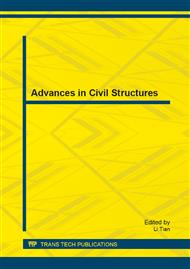p.986
p.990
p.998
p.1004
p.1008
p.1014
p.1018
p.1024
p.1028
An Experimental Study and Analysis of Full Process of External Prestressing CFRP Concrete Box Girder
Abstract:
A full rang of external prestressing CFRP concrete box girder flexural performance have been tested. Crack distribution, deflection,strain distribution, stress increment of external CFRP have been measured. The results demonstrate that that as the load increase, the shear lag phenomenon on the upper and bottom plate of the box girder is more significantly; There is a certain friction Loss on the interface between CFRP and two steering block which arrange in the mid-span. If suitable element models and material constitutive laws are chose, the ANSYS program may simulate the fully flexural experimental process of the box girder, the result is well agree with the experimental result.
Info:
Periodical:
Pages:
1008-1013
Citation:
Online since:
August 2013
Authors:
Price:
Сopyright:
© 2013 Trans Tech Publications Ltd. All Rights Reserved
Share:
Citation:


